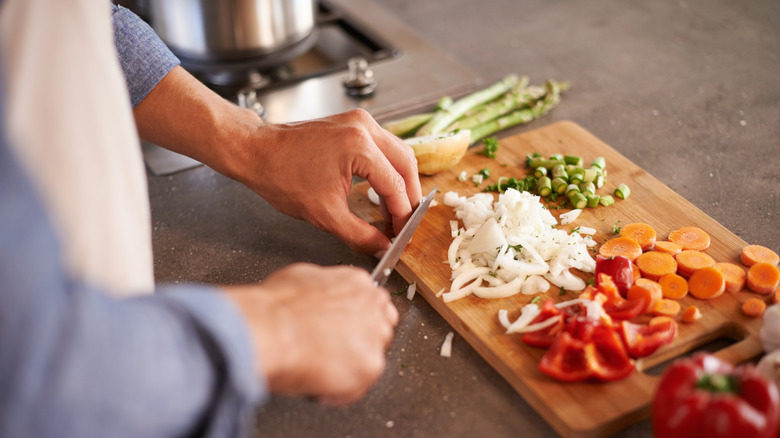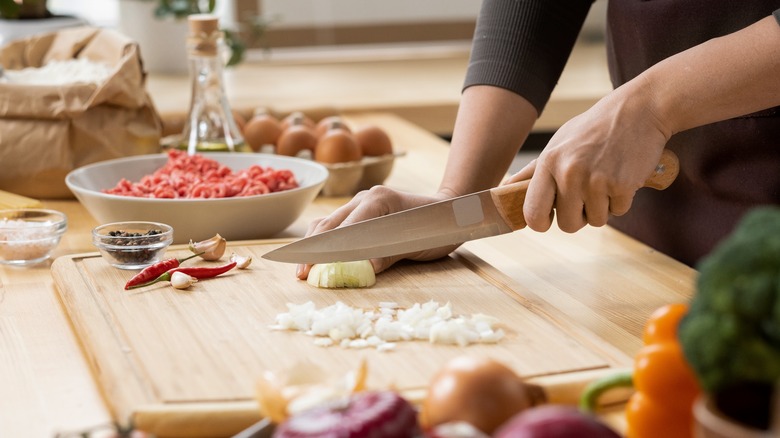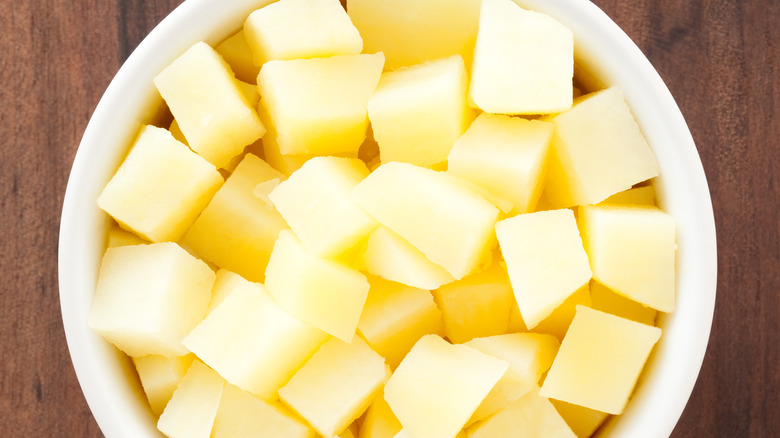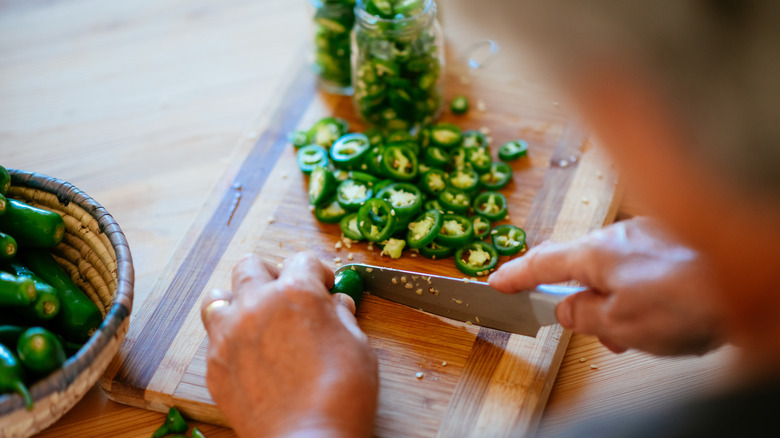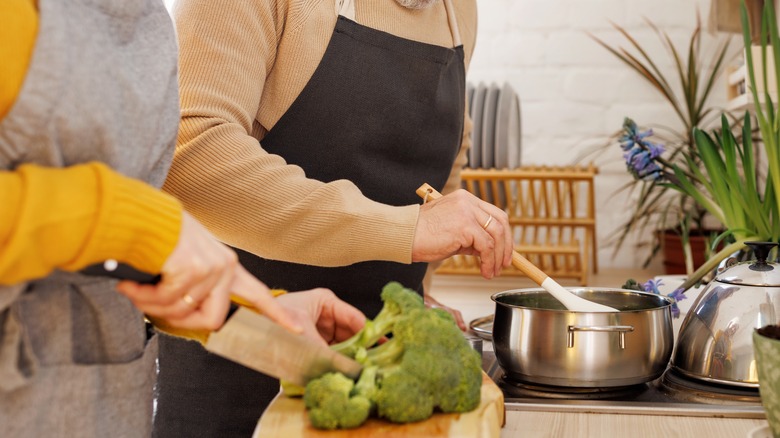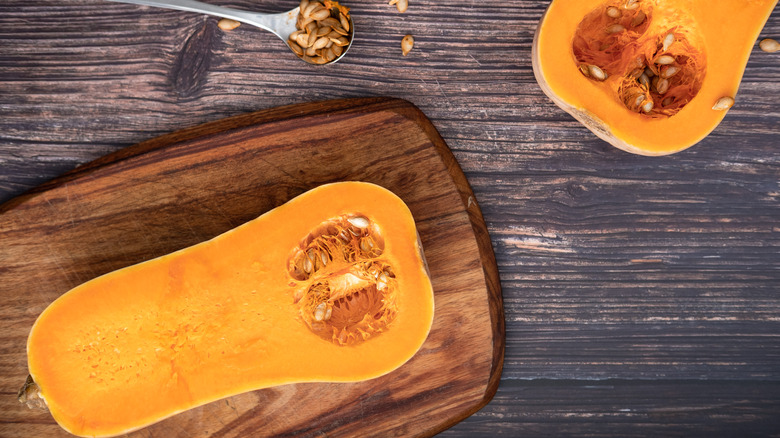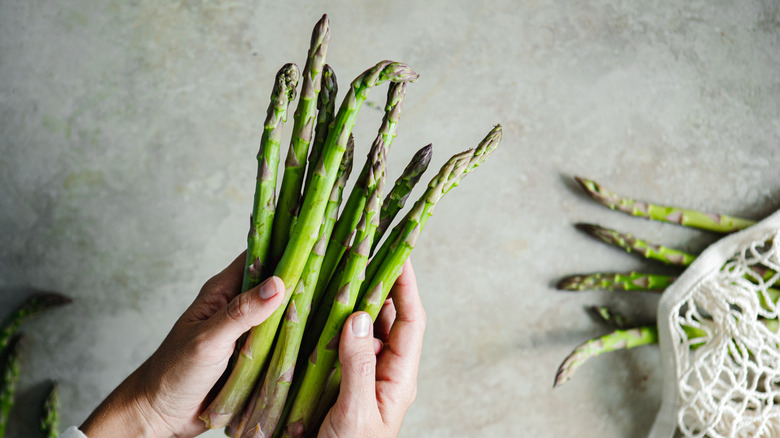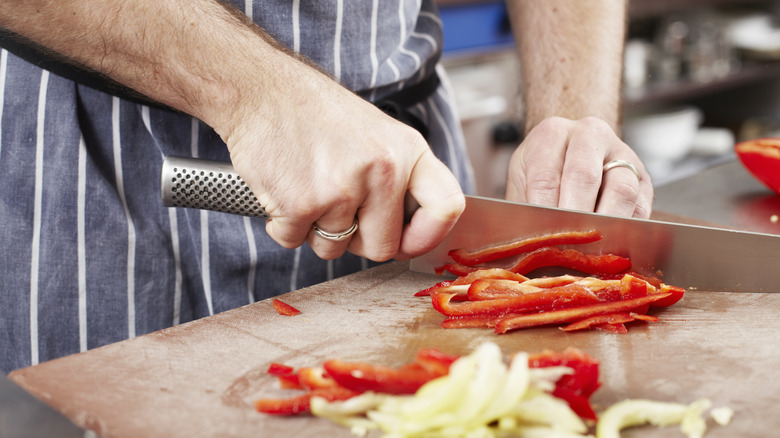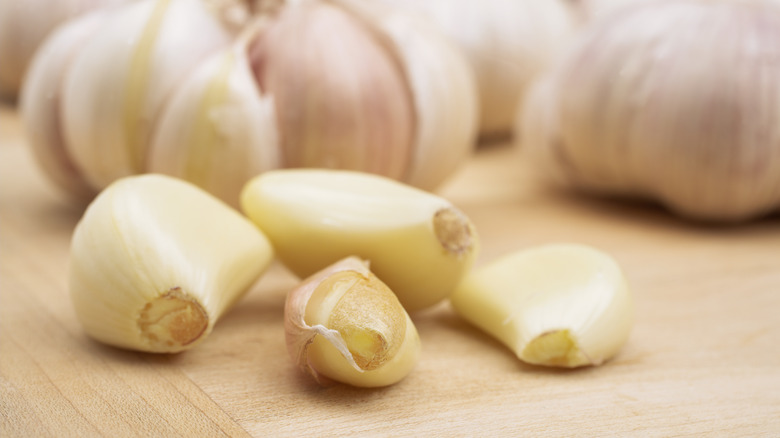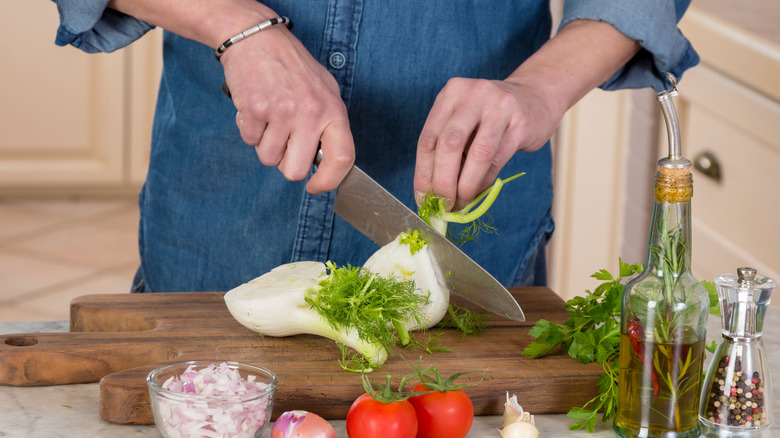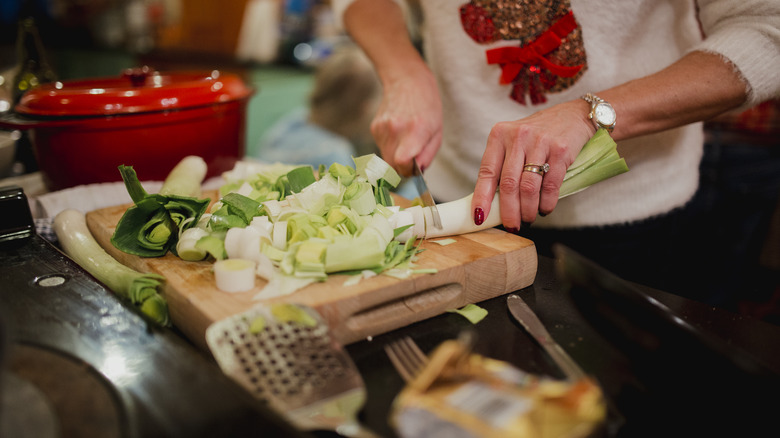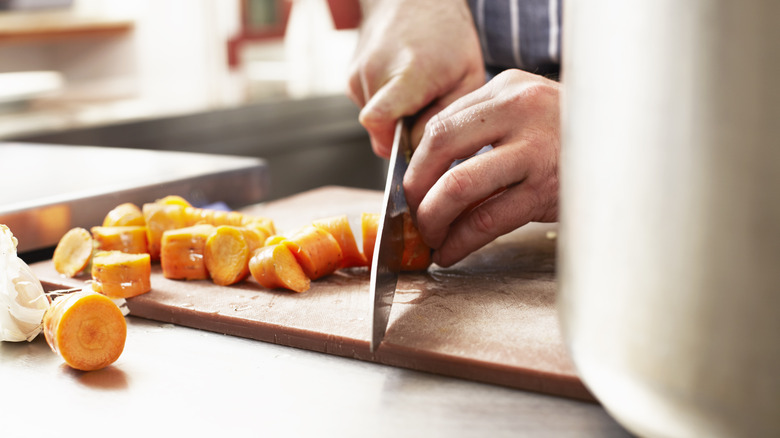Vegetables You've Been Cutting Wrong This Entire Time
When it comes to weekday dinners, cooking a balanced meal can often feel like one more chore to check off the list. It's tempting to rush through steps, especially when prepping, to get that meal on the table faster. The first thing to go in the great sacrifice to save time? The vegetables.
While chopping and dicing can seem relatively straightforward, you may be leaving a lot, quite literally, on the cutting board if you don't add a method to the madness. Hacking away at a pepper or dicing a potato willy-nilly can get your ingredients into the pan more quickly, but you could also be cutting away the key nutritional benefits of your food in the process. Uneven cuts can also lead to uneven cooking on the stove or in the oven, resulting in a not-so-tasty meal. What's worse, rushing can cause cuts, burns, or even tears. (Thank you very much, onions.)
Fortunately, you can avoid these pitfalls by taking an extra moment to chop your vegetables correctly with these key hacks. Once they become a habit, you'll never chop vegetables the wrong way again. Who knows — maybe it'll lead you to work more vegetables into your diet, too.
Avoid tears by keeping onions cold and using a sharp knife
Onions are a vital part of many recipes, but slicing and dicing them can be a bit dramatic. While your first impulse may be to chop an onion quickly to avoid the inevitable waterworks, taking a second to prep and slice an onion correctly can save you the tears and aggravation.
Chopping into an onion starts a chemical reaction that prompts the onion to release an irritant as a defense mechanism, resulting in watery eyes or blurred vision. Start your chopping with a sharpened knife to help minimize the amount of irritants the onion releases. Chilling onions in the fridge or freezer can prevent irritation. Cold temperatures slow down the chemical reactions within the onion that cause it to produce the gas that's offensive to your eyes, he says.
From there, dicing is a breeze. To start, peel your onion and keep the root intact, then cut off the other end of the onion. From there, slice the onion in half through the root. Place it flat-side down on the cutting board and make several horizontal cuts into the onion, then make several vertical cuts without cutting into the root. Finally, with the root facing toward you, begin to cut crosswise slices as evenly as possible. From there, you'll have a perfectly diced onion for recipe favorites, like a delicious all-purpose tomato sauce.
Dice potatoes more easily with the stack-and-slice method
The last thing you want when making scrumptious rosemary and garlic roast potatoes for dinner is a mix of burnt and chewy potato bits. Fortunately, evenly diced potatoes can save your favorite side before it even goes into the oven.
Using the simple stack-and-slice method can help you create chef-quality cubes that make your potato dishes taste and look great. Before you get to chopping, scrub your potatoes free of dirt and peel them if you don't want the skins. With a well-sharpened knife, cut off a small strip of potato lengthwise, creating a flat surface. From there, continue to cut even strips lengthwise to create potato rounds. Stack your potato rounds and cut lengthwise again to create a matchstick shape, perfect for french fries if you want to stop there. To continue onto cubes, cut your stacks evenly widthwise into square shapes. These perfect cubes make for the perfect little bite.
Protect your hands from jalapeño burns with this easy chopping hack
Anyone who likes a spicy pepper in their sauce or stew will know that slicing spicy peppers without getting burned is no easy task. Jalapeños, like many of its fiery cousins, contain capsaicin, a component known to give a pepper its heat. While spicing up a dish can be tasty, having that spice linger on fingers – or worse, eyes – is not ideal. Slicing your jalapeños with minimum skin contact is therefore essential and more possible than you may think.
First things first — you may want to protect your hands by wearing latex gloves before you start handling jalapeños. While this slicing method can prevent you from touching seeds, if you continue to chop your jalapeño further, direct contact can cause some lingering burns, even when the seeds have been removed. Take precautions based on your comfort level.
Now it's time to start slicing. Hold the jalapeño up vertically from the stem, bracing it on the cutting board to prepare it for slicing. With a sharp knife, slice off the skin with vertical cuts, moving the knife downward. Rotate the stem to slice away all the skin from the jalapeño. When you're done, you'll be holding the stem, pith, and seeds without having touched the jalapeño flesh. Discard the stem and seeds, then enjoy some delicious heat.
Turn broccoli upside down to avoid a mess
If you're looking for a simple, nutritional side to go with dinner, broccoli tops the list. When tasked with chopping up a full head, however, it can be difficult to know where to start. While hacking away until you get easy-to-roast florets can seem like the easiest option, the green mess that often results can add time to your post-dinner cleanup.
Instead of reaching for the pre-chopped florets bag at your grocery store, try this simple cutting method that reduces the mess and produces the best florets for roasting. Hold the broccoli head upside down on the cutting board while grabbing firmly onto the stalk. With a sharp knife, cut away smaller broccoli florets from the smaller stems that naturally branch out from the stalk. If you need even smaller pieces, continue to cut from the smaller stems until you achieve the size you want, or pull apart your florets and then trim off the stems you wish to discard. Throw away the stalk (or save it for a vegetable broth) and you're ready to roast.
Halve a butternut squash to make it easier to tackle
Nothing says comfy fall cooking quite like butternut squash soup, but before you savor the autumnal sweetness, you have that big, tough orange vegetable to contend with. Tackling an unfamiliar, seasonal vegetable like butternut squash can be a challenge — and require a little bit of muscle — but if you go in with a chopping strategy, you can dice and slice with minimal effort to get that soup on your table faster.
Start by removing both ends of the butternut squash, then cut it in half widthwise. Peel off the skin from both ends with a regular vegetable peeler, then take the more bulbous half and cut it in half once more. With a spoon, remove the seeds from the bottom half of the squash, and then proceed to cut the top half of the squash in half once more. From there, make vertical slices and then horizontal slices to create easy-to-roast cubes that will make pureeing quicker too.
Give asparagus a snap, then slice it
Is it really that difficult to chop asparagus? If you've ever bit into a stalk and found the bottom bitter and difficult to chew, you'll know it's not as simple as it looks. Finding the right spot to slice off the woody, white bottoms of asparagus without forsaking too much of the delicious green stalk isn't always something you can spot by eye. Fortunately, there's a foolproof method that saves time and a good portion of your vegetables.
Hold your asparagus from the white bottom to roughly where the flesh becomes a vivid, green color. Then, gently snap off the stem to naturally find where the inedible part ends on the stalk. Once your first piece is snapped, instead of snapping the others and winding up with jagged edges, line up your other asparagus pieces next to the newly trimmed piece, and use it as a guide to cut the stems off the others. When you're finished, all the bottoms will be removed without sacrificing too much of the actual vegetable. Proceed to cut further if you want smaller pieces.
Easily remove seeds from a bell pepper
Raise your hand if you feel like you've never actually cut a bell pepper quite the right way. You're not alone — even if you use bell peppers often enough in your cooking, you may not have locked down one solid method to remove the flesh and seeds while creating even slices. While a few methods out there can satisfy this task well, this one may be the easiest.
To prepare simple one-pan fajitas — or a host of other dishes that star bell peppers — start by cutting about a half-inch off the top and bottom. Proceed to make two vertical cuts across the flesh of the pepper to help open it up. Lay the pepper flat with the flesh side up on your cutting board, then gently slide your knife over and away from you to remove the pepper's ribs, white flesh, and remaining seeds. Once the white parts are removed, you can slice vertically for thin or thick matchsticks that sauté well in many recipes.
Mince garlic with minimal effort
If you don't have a garlic press, fret not — mincing tiny cloves into even tinier pieces is actually simpler than you think. With the right technique, you'll have one of the most fundamental ingredients to any recipe ready in no time for your at-home aioli recipe, or any dish that needs a flavorful touch. Best part? You don't have to be afraid of cutting your fingers.
To start, place the full bulb of garlic face down on the cutting board with the root up toward you. With the heel of your hand, press down on the bulb to free the smaller cloves of garlic. If you have the time, let the garlic cloves rest overnight to easily remove their skins like a pro. For when you're short on time, remove the clove's skin by laying your knife, flat-side up, on top of the garlic, and pressing down once again with the heel of your hand. Repeat this step when the peel has been removed to further crush the garlic. Cut away the ends of the garlic, then give it a rough chop once vertically and once horizontally with rocking motions. Continue to mince with those rocking knife motions until your garlic clove is fine in texture.
Use fennel more in your cooking with this easy chop
If you've stayed away from fennel in your cooking thus far, you're truly missing out. A deliciously sweet vegetable with a slight aniseed flavor, fennel can be eaten raw or cooked, and makes a nice addition to a fresh salad or a decadent side with roast chicken. If you've never tackled fennel because you don't know where to start your chopping, there's a foolproof method that'll get you the chef-quality slices you're looking for. From there, the sky's the limit on how you use fennel in your cooking.
First, cut closely to the bulb to remove the stocks and fronds from the fennel. Peel off any tough outer layers or layers covered in dirt. Halve the fennel lengthwise, then use the tip of your knife to cut a triangular-shaped wedge along where the core and the rest of the flesh meet, removing the core. Place the fennel flat-side down on the cutting board, and slice downward widthwise to create semi-circles for the perfect salad. To create more classic strips, slice downward lengthwise, then try them out in your new favorite recipe.
Clean and cut leeks perfectly
Similar to fennel, you may be a stranger to leeks in your cooking, but these celery-looking chutes are worth the small hassle. Whether you're looking to cut leeks to stuff them or craving their light, oniony flavor in a savory pie or soup, this essential vegetable to French cooking can transform your dish once you know what to do with it.
When you first grab hold of your leek, you'll notice it looks very similar to a green onion or scallion, and to start you'll be handling it a similar way. Begin by cutting off the roots and dark green tops of your leeks. Then, for more manageable pieces, cut the remaining stalk into 4-inch sections.
Because leeks are grown in sandy soil, it's vital to wash them thoroughly to remove all remaining dirt. To do so, first, slice the leek pieces in half lengthwise and let them rest in a baking dish filled with water. Once you see a sufficient amount of dirt has floated to the bottom, you can take the leeks out and dry them with a paper towel. Finally, slice the leeks widthwise to produce semi-circles that cook down more easily. If you prefer, you can also chop the leeks into semi-circles first and then proceed to wash them of dirt before you cook them.
Chop and slice tomatoes without losing the seeds
There's nothing like a ripe summer tomato to brighten up a dish. Whether you're throwing a colorful heirloom into a salad or dicing up Roma tomatoes for a homemade sauce, this incredibly versatile fruit can find its home in any recipe. Fortunately, just because there are many types of tomatoes doesn't mean you need to cut them all differently – there are a few tricks you can apply to any red shiny fruit that finds itself on your cutting board.
The most important tip of them all is to make sure you're using the right knife. A serrated paring knife works perfectly to cut the slippery interior and soft exterior of a tomato because it forces you to cut across in a saw-like motion instead of downward. This puts less pressure on the tomato, preventing any seeds from squishing out.
With your serrated knife in hand, cut off the stem of the tomato by using the tip of the knife to trace a circle around the stem, creating a small wedge. Remove the wedge and slice from the stem down, making the aforementioned sawing motions with your knife. If you're looking to dice, halve the tomato through the stem instead and then quarter it. Cut these quarters in half once more until you have eight tomato wedges, and then cut each wedge crosswise to create cubes.
Julienne carrots into the perfect matchsticks
If you're looking to reach chef status with your vegetables — or simply need to slice veggies perfectly for a spring roll recipe — you'll need to master the julienne. While the julienne can be used for a variety of different vegetables, including bell peppers, it's particularly useful with carrots to create even matchsticks for a great kid-sized snack or to start the quintessential sauce base, the mirepoix. The technique may sound a bit intimidating, but it's a lot easier than you may think, and once you master it, you'll find it has many practical applications in cooking.
Start by slicing off the stem of the carrot and then use a peeler to remove the outer flesh. Segment the carrot into your desired length, then slice off one of the rounded sides of the carrot lengthwise so it can sit flat against the cutting board. From there, continue to cut lengthwise until you have a small deck of card-sized carrots. Similar to dicing potatoes, stack your carrot strips on top of each other to cut lengthwise once more, creating matchsticks. For smaller cubes, continue to cut the matchsticks lengthwise into tiny, even chunks for the perfect sauce base.
